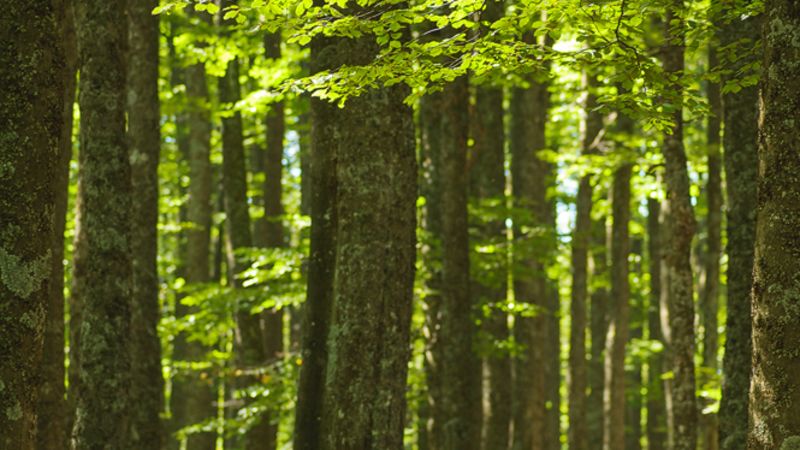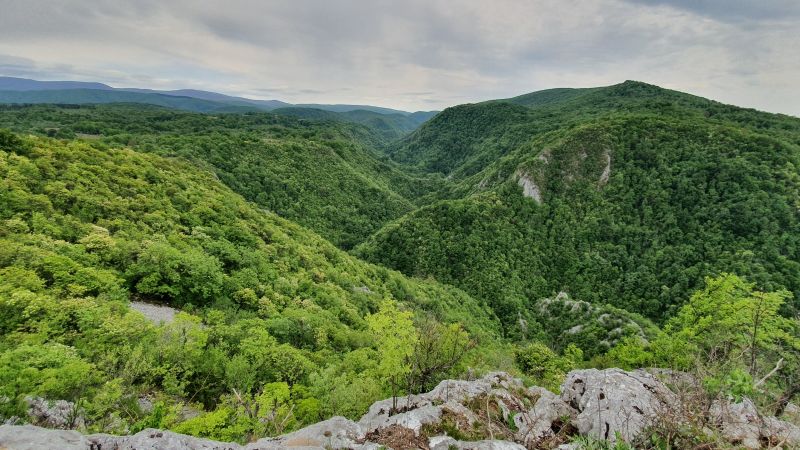Natural attractions
Izvoarele Nerei Nature Reserve, part of the UNESCO site: The "Izvoarele Nerei" nature reserve, which covers 5028 ha, is one of the largest virgin forests in Europe. This forest, as a nature reserve, has a restrictive protection status according to Romanian legislation. The reserve was established in 1973 by forest management planning, first as a "forest reserve", and in 2000 it became a "natural reserve". Representative are the virgin ecosystems of pure beech trees, where only a few specimens of other tree species can be found. The trees impress with very high volumes (600-1200 mc/ha) and the base surface (52-54 sq/ha), as well as the presence of impressive trees, with diameters over 1.3m, heights over 50m, ages over 400 years. The amount of dead wood is also impressive, representing 8-10% of the volume of the live stand. The understory is poorly represented, as is the herbaceous cover, most of these stands being bare beech. Regeneration is done according to natural laws.
Starting with 2017, the Natural Reserve Izvoarele Nera, was declared as a UNESCO World Heritage Site "Primary forests from the Carpathians and other regions of Europe". The surface of the nominated component is 4677.7ha and the buffer zone is 2496ha.
- The UNESCO Site component represents the most representative compact body of forests with a high degree of naturalness in Romania, being one of the most important components at the pan-European level.
Comarnic Cave nature reserve: Length: 6.2km, elevation difference -100m. The Comarnic cave is formed by the Ponicova stream which crosses the Navesul Mare hill underground, formed by Calcare de Valea Aninai, layered with intercalations of flint and Calcare de Plopa, compact. The cave is structured on three levels, the inactive level (tourist route, visitable), the temporary active level through which the water flows during floods or high flows, and the active level through which the water flows permanently. Characteristic for the inactive level are the large galleries with sand beaches, columns, domes, stalactites, stalagmites, collapse halls and trains of roared On certain sections of the gallery there are stalagmite slabs and large calcite basins (gurures), sometimes filled with water. The characteristic fauna consists of more than 120 species of invertebrates (gastropods, oligochaetes, araneids, mites, opilionids, isopods, diplopods, collembola, trichoptera, coleoptera, diptera) and mammals (chiroptera). Terrestrial species of invertebrates, amphibians, reptiles and mammals accidentally arrive in the cave. The visitable route is 1,750 m long and includes the Comarnic entrance, the Small Hall with Blocks, the Great Hall with Blocks, the Museum, the Great Organ, the Chinese Walls, the Treasury, the Cathedral Hall. The duration of the route is approx. 2 hours.
On the visitable route, you can see a wide variety of morphological forms (erosion levels, spoons, sand beaches and alluvium, terraces, septa) and forms of chemical precipitation (stalactites, stalagmites, columns, domes, curtains, slabs, crusts, pools). Sometimes bats can be observed in colonies or isolated specimens. The cave can only be visited accompanied by rangers - authorized tourist guides of the Administration of the Semenic National Park - Cheile Caraşului. The route is made of minimal facilities and lasts approx. 2 hours. It requires special attention to prevent slipping or hitting the ceiling/rock walls. The visiting schedule for groups of at least 5 people is between May and September, on Saturdays and Sundays. Monday - Friday we provide a guide only upon request made in advance at least 24 hours before the visit, for a minimum group of 5 people. The visit requires suitable footwear for the mountain and clothing suitable for a temperature of approx. 10 degrees and high humidity. The visiting fee is 15 lei/adults and 10 lei/students.
These ecosystems have been preserved intact since the last glaciation. Tree age determinations carried out at an altitude of 1000m revealed the presence of 8 trees/ha over 400 years old, respectively 16 trees/ha over 350 years old with a determined maximum of 477 years. (D. Turcu 2012). In 2017, a 526-year-old tree was identified. The forest habitats were not specifically mapped on the surface of the entire Reserve, but habitats 9110 and 9130 were identified, the existence of other beech habitats on acidic soils being probable.
Cheile Carașului Natural Reserve: It can be visited on two tourist routes:
The Caraşova – Comarnic route, marked with a blue triangle, is 9.2 km long and crosses the Caraşului Gorge between the town of Caraşova and Poiana Prolaz over a distance of 5 km after which it crosses the limestone plateau to Comarnic and the cave of the same name. The connection with other routes is in the Comarnic area with the marked route (blue lane) towards the town of Reşita or the town of Anina; with the red cross route to Villa Klaus and Semenic Resort. The main route and the European route (E3) Reşiţa – Gura Golumbului, marked with blue tape, is 35.5 km long and crosses the Cheile Carașului / Cheile Buhuiului between Comarnic and Anina (Orasul Nou district) for a distance of 13.5 km. The connection with other routes is in the Comarnic area with the marked route (blue triangle) towards the town of Caraşova; with the red cross route to Vila Klaus and Semenic resort. Length: 19km, maximum depth 200m. The Caraş gorges are formed by the Caraş river that eroded the Jurassic and Cretaceous limestones. The slopes are predominately with cliffs, slabs, vertical walls and pits at the base. The river meanders, forming brooks and calcareous ridges that descend from the edge of the gorges to the water. On the plateaus bordering the gorges, there are numerous fields of boulders, sinkholes and ravines, and on the slopes of the gorges there are over 400 caves and karst springs. The slopes are partially covered with chasmophytic vegetation of bushes (Cornus mas, Carpinus orientalis, Syringa vulgaris, Ruscus aculeatus) or trees of the species beech, gorun, cer, on the gentler slopes. Hygrophilous vegetation grows along the water with associations of Petasites hibridus and on the banks Salix eleagnos trees.
In the gorges and tributaries there are numerous species, characteristic being the reptile species Vipera ammodytes, the amphibian species Bombina variegata, the fish species Barbus meridionalis, the invertebrate species Austropotamobius torrentium, the mammal species Myotis myotis, Lynx lynx, Canis lupus and bird species Aquila pomarina, Bubo bubo. In order to protect the landforms, the habitats and the identified species, the Cheile Caraşului Natural Reserve was designated.
Nature reserve 2.287 Buhui-Mărghitaş,
declared by Law no. 5/2000 regarding the approval of the National Territorial Development Plan - Section III - protected areas, with an area of 979 ha.
The hydrographic network is well represented, valleys with a fairly high density, with permanent and constant flow, feeding the Buhui reservoir (S=9.5 ha).
The main watercourses are the Buhui stream, the Romanovăt stream and the Glăvan stream. The Buhui Stream downstream from the reservoir enters underground at the Buhui Cave to reappear after about 600 m downstream. The Buhui stream is a tributary of the Caraşului valley. Lake Buhui It is unique in that it was built on limestone in 1884 by the Austro-Hungarian administration with the aim of supplying water to the city of Anina.
It occupies an area of 9.5 ha, has a depth of approx. 20 m and a volume of 500,000 m3. The water from the lake passes through the Buhui Cave, then through a new catchment (underground) it is directed through an artificial tunnel in Anina.
The shores of the lake are wooded, the species present being: fir (Abies alba), beech (Fagus silvatica), hornbeam (Carpinus betulus), hornbeam (Fraxinus ornus), larch (Larix decidua), Douglas fir (Pseudosuga meuziesii). On the lake you can take leisurely boat trips.
Access: car on DC (unpaved road!); pedestrian on the tourist route Resita - Danube, blue tape marking.
Sequoiadendron gigantea
These giants of the vegetable kingdom are found in large numbers in California. Sequoia is part of a species of gymnosperm that can live for thousands of years, and at maturity it can reach 145 meters in height, with a stem circumference of up to 38 meters.
Giant sequoia trees are among the tallest creations on Earth today. The name "sequoia" is given in honor of the leader of the Cherokee Indians Sequoyah (1776–1842), who invented a unique alphabet, teaching his people to read and write.
One of the first books in the Cherokee language was the Bible (1825).
In Semenic National Park - Cheile Caraşului there is a specimen of Seqoiadendron gigantea in the Navesu Mare area.
This tree grew in natural conditions at an altitude of 670 m and impresses with its dimensions, which are: circumference of approx. 5.70 m and height of 40 m.




